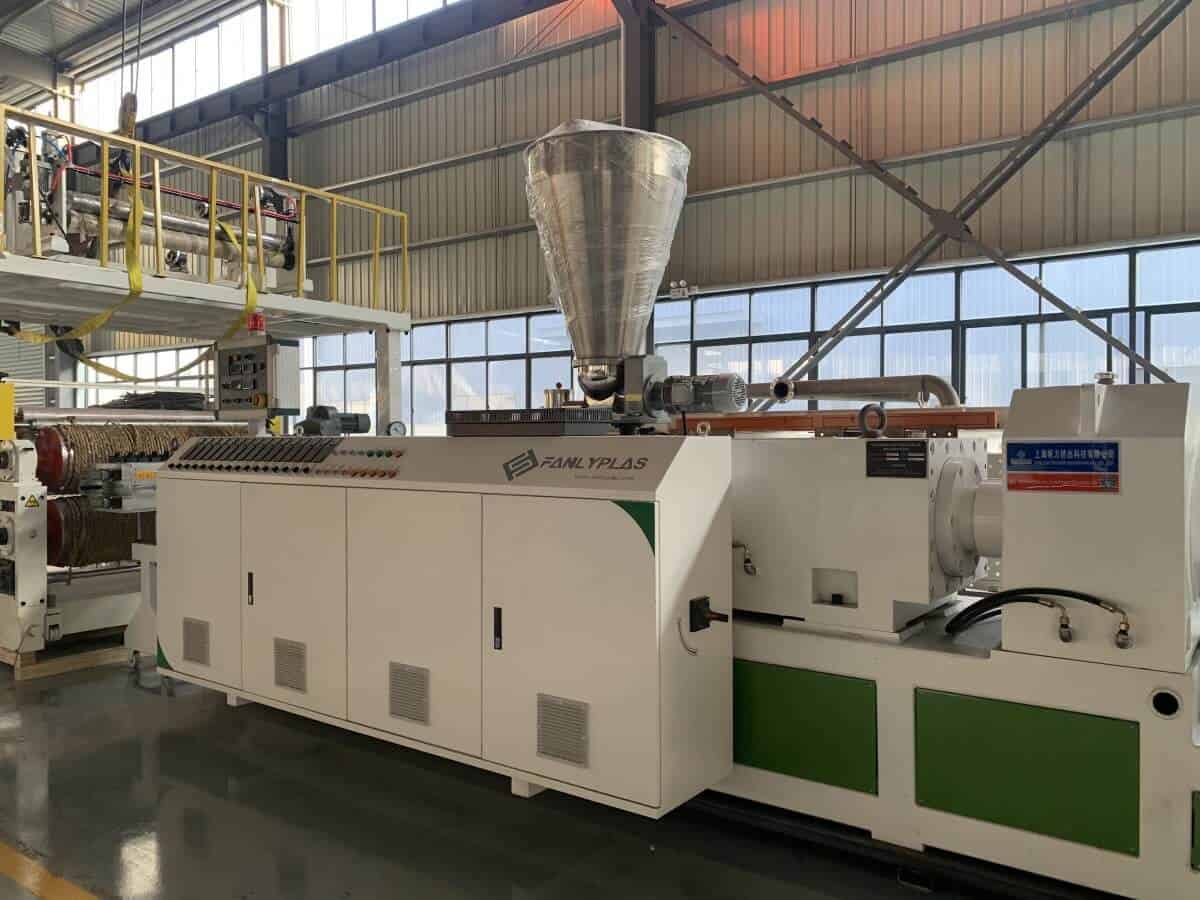Introduction
PVC foam boards are becoming a sort-after option as a substitute for other materials such as wood, plywood, and aluminum in various kinds of applications. This has led to an increased demand for the PVC foam board production line. The after products have varied uses ranging from; directional signage, swimming platforms, menu boards, display boards, and many more construction and furniture applications.
That is all thanks to the durability, quality, sustainability, eco-friendly, and high dependable nature of these PVC foam boards. However, while the PVC foam boards are still under the PVC foam board extrusion line, many challenges come along and impact their production process. This publication will look into some of the key factors and the challenges encountered by PVC foam board manufacturing units.
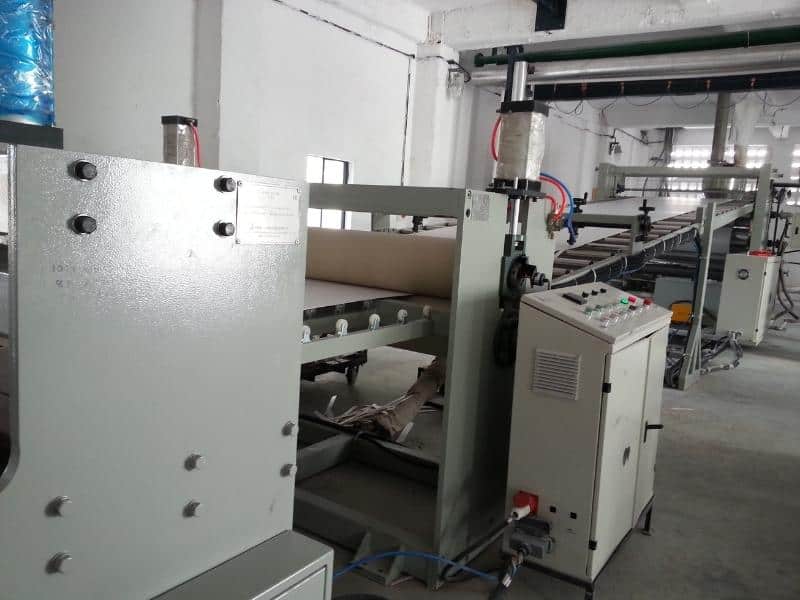
What are the factors affecting PVC foam board production?
Material retention
The Retention ability of a material under extrusion of PVC foam board production line is one of the many factors that affect the production. This is the time material spends in the extrusion barrel or the twin conical extruder and the T-die segments. It affects the well-being of the final product at the end of the production line. When the material stays in these two components for a short period, the foaming agent will not decompose completely. Remember, the foaming agent must completely decompose. Therefore, a short period in the two components will make the final product come out with very high densities.
On the other hand, when the retention time is too much, the foaming agent in the barrel will over decompose. This leads to an increase in the foaming agent density and also the density of the product. At any given stage of the extrusion processing line, one must monitor the time spent and regulate it.
The speed of the PVC foam board production line
Extrusion speed is necessary during the production line and needs to be checked frequently. The controller of the extrusion production line must ensure that all components in the extrusion line match the speed of the extrusion line. On average, the speed of an extruder is always around 13-18 rpm. The speeds can also go top-notch and reach speeds of up to 25 rpm. Speed needs to be regulated according to the type of extrudate under production and the particular stage in which the material is in.
High speeds in the extruder always come later since the screw must first begin at slow speeds. High speeds cause too much pressure to build up in the extruder, therefore, damaging the machine. It is in the T-die where speeds are accelerated depending on the given pressure under which the extrudate will not be damaged. High speeds in the entire machine need to be avoided since they cause the product to come out with high densities. High-density material makes the drawing machine unable to pull the material in place since the sleeve blocks the material.
Traction
Speed also increases friction within the barrel and causes the material to gain a lot of heat and also expand in the mold. Cooling the material also becomes difficult. This does not make low speeds favorable for the extrusion production line. It is because low speeds also have their consequences. Low speeds make the final material come out with a rough and rigid surface and the material size reduces as well.
As previously stated, low retention time in the barrel and the T-die makes the material gain high density. Low speeds make the material overstay in the barrel and the foaming agent decomposes less. The speed of the screw in the barrel needs to be regulated to increase the stability and flow of the extrudate.
Uncelebrated equipment instruments
An extrusion machine comes with lots of accessories and instruments that all play vital roles in the production line. These instruments need to be checked on at least twice a year to ensure they are in good form and shape. They include temperature monitors and regulators, pressure regulators, RPM meters, and amperage. They need to be calibrated and set to correct frequencies. This will ensure that one gets uniform products throughout the entire year. If these components are not checked and reset, then expect your final product to come out with issues.
Resin steady state
Before the PVC foam board production line operation begins, the core materials used also called resin need to be in good foam. Any resin that gets caught up with some unwanted features must not be used at all in production. A quality resin will only produce extraordinary PVC foam boards. When the resin is poorly stored or mixed with other unwanted material before the production time, it must be excluded from the operation.
In that case, storage matters. Therefore, you are required to store your resin in a cool and dry area. This will eliminate the dumpiness factors that might affect the quality of the material. You can also go the extra mile by introducing a quality analysis check of the resin before you begin the extrusion process. The resin quality check will include accessing the melt index, viscosity index, tensile strength, and shear strength as well. When all is checked, you can proceed and begin extrusion. Only by doing so, will you eliminate doubts and remove quality-related issues.
Cooling water temperature
During the PVC foam board extrusion production line, cooling of the boards is necessary. On average, the cooling water temperature needs to be below 15 degrees Celsius. However, temperatures below 5 degrees Celsius work pretty well. High cooling water temperatures are not favorable for cooling since the cooling process is never effective in high-temperature waters. The high cooling water temperature has its effects on the PVC foam board. The board comes out with extremely low hardness and uneven pressure when cooling.
At the same time, the flow rate of the cooling water also matters. If the flow rate is slow, then the PVC foam board comes out with a very soft surface and you can notice some irregular color tunings on the surface as well. When the cooling water flow rate is high, the PVC foam board will foam shrink which makes the appearance unappealing.
Melt temperature
In the entire PVC foam board production process, the temperature applied in the process is vital. It must be regulated all time and in specific stages also depending on the specific type of material under the extrusion process. Melting is usually the first stage in the extrusion production line. It is a process that uses heat to break down the resin and other additives into fine and viscous extrudate that can be foamed and shaped in various designs through the entire extrusion process.
The melt temperature is the applied of most preferred temperature that is applied in meting down of the material. This temperature needs to be regulated and controlled so that uniformity, consistency, and quality are upheld.
https://fanlyplas.com/pvc-foam-board-production-line/Melt temperature is crucial since it determines how the internal and external structure of the PVC foam board comes out. That is; Bubble structure, density, and external surface properties. Other properties that affect the necessary melt temperature are The K value of the resin formula and the sheer force of the resin as well. Therefore, temperature control is very important in the entire PVC foam board extrusion line. Always make sure that the temperatures are gradually increased so that the properties of the material such as density and sheer strength are just perfect.
On top of that, low temperatures also make the extrusion surface rough therefore affecting the foaming process. It particularly affects the decomposition of the foaming agent as it delays the decomposition process. The foaming agent continues to decompose while in other states that do not allow for proper foaming to go on.
Barrel feeder temperature
The temperature inside the feeder of the barrel needs to be controlled as well. One principle remains clear and that is; that temperatures inside the feeder barrel should never be high. It is because high temperatures make the material decompose prematurely and the products become bridged and blanking will be smooth. It is wise to always maintain the temperatures to about 145 degrees Celsius for optimum results.
Flange and Head temperatures
High temperatures in this section are usually deadly. One needs to be extra careful and keen while dealing with this area. High temperatures are the primary causes of bubble hole raptures, poor strength of the material, rough surface, and paste-like mold formation. Low temperatures are also not preferred since they bring a lot of poor surface appearance and poor plasticization. To get the best result in this section, you must ensure that the end temperature of the barrel is slightly high than the head of the machine.

PVC foam board extrusion process
It is through this process that we get PVC materials that replace wood, plywood, and other materials applied in furniture making and construction. The process of production of PVC foam boards is usually a complex and dynamic one. There are tons of processes and activities that take place inside the extrusion machines for a final product to come out. Here is a brief but detailed of how the PVC foam board extrusion line works through every individual component:
Mixer
The initial production stages begin within the mixer. It first mixes the different raw materials used for production. It comes in two parts. We have;
Top tank
The top tank plays a very crucial process that involves removing moisture from the raw materials and chopping down the raw materials into powdery foam. It is cylindrical and comes fitted with a heater (for heat removal) and a blade (to chop down the raw material into small bits).
Bottom tank
Located beneath the top tank, this part is important and used to cool down the heated raw materials from the top tank. The reason for cooling down the mold to 45 degrees Celsius is to avoid decomposition and plasticization that occurs due to high temperatures. To get the cooling process done, the bottom tank has a cold-water input and a hot water output. After the process is complete, the materials now move to the next equipment.
Screw loader
This is rectangular-shaped equipment from which the raw materials from the top tank and bottom tank are fed into. With a set time to ensure it conveys up to 200 kilograms of raw materials to the up part of the extruder known as the feed hopper. Inside the screw loader, there is a rotating helical screw that scoops the raw materials and feeds them directly to the feed hopper.
Conical twin-screw extruder
Other known as the heart of the PVC foam Board extrusion line, it plays a very crucial role in the entire production line. When the raw materials from the feed hopper and other PVC resins get into this part, they are heated and plasticized. To generate heat for the process, there are cast aluminum heaters located under the barrel that heats the PVC resin and other additives. On top of that, heat is also generated from friction that is caused by the two screw-rotating screws inside the barrel.
The twin conical screw conveys the raw materials to another stage and at the same time plasticizes it as well. High temperatures and extremely low temperatures could affect the entire process. Therefore, the temperatures inside the conical twin-screw extruder need to be controlled. There is an in-build temperature controller for that.
T-die
After the entire raw materials, additives, and PVC resin are all blended and plasticized together, the mold now moves to the T-die. Under this section, the mold is shaped and foamed into its desired size. However, the foam keeps on expanding. The T-die prevents that from happening with help from the molds in the machine that ensure the desired shape and thickness are achieved. It is from here that the general shape of the foam is made.
Calibration table
The calibration table houses the necessary equipment that is responsible for the perfect shaping and sizing of the extrudate. Two main activities happening inside the calibration table are cooling and foaming. The 4 molds all play a collective role in ensuring that is done.
Foaming is a process that involves producing a small mass of bubbles on the interior surface of the PVC foam board. The process happens through depressuring the molten PVC to remove gases dissolved inside the mixture and through adding foaming additives.
After the foam is complete, the extrudate now moves through the molds that compress and foam the right and perfect shapes and sizes. After that, cooling of the boards now comes next. That is achieved with help of oil cooling temperature which is responsible for controlling the temperatures of the extruding molds. We also have cooling by use of water that runs in cycles through the molds.
Cooling bracket
After the PVC foam boards leave the calibration table, they are conveyed to the cooling bracket with help of a roller. The cooling bracket is just an extension to the cooling system only that the boards are exposed to the surrounding air. You can get a cooling bracket fixed with a cutting machine that trims rough edges into perfect and seamless shapes.
Hauling machines
This machine conveys the foam boards to the cutter. Rollers help get the boards to the perfect position for cutting.
Auto-cutter
It is a computerized cutter that runs with help of photoelectric sensors and a computer to cut the boards into sizes and shapes precisely.
Dust collector
This is a vacuum collector that is placed on top of the auto-cutter to collect dirt and dust.
Stacker
Collect finished PVC boards and stack them into perfect piles with other finished boards.
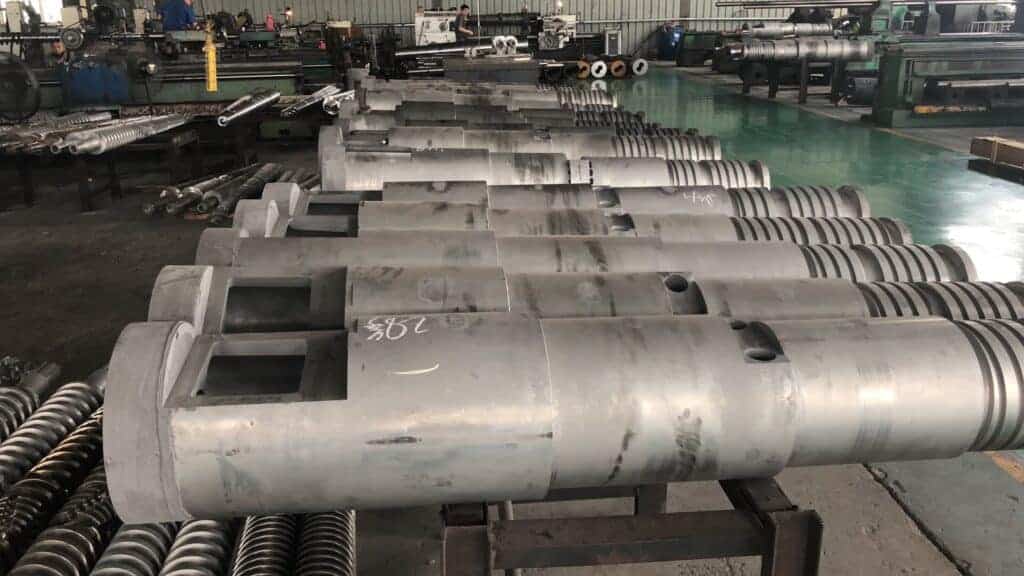
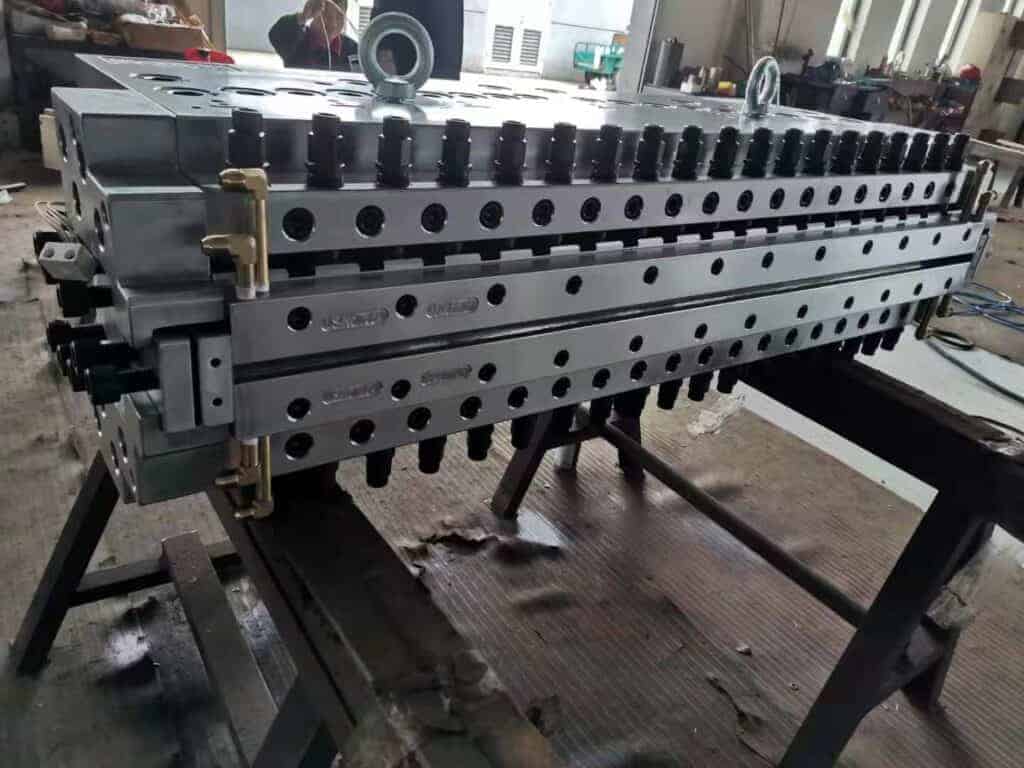
Different types of PVC foam boards
PVC foam boards come in different forms. They include;
Skin foam board
Skin foam boards are mostly applied in interior works. That is, making of cabinets and desk and generally most of the interior furniture. One notable feature of this type of PVC foam board is its anti-scratch nature, top-notch hardness, and irresistible smoothness.
Co-extrusion PVC foam board
These are an improved version of extrusion PVC foam boards. During production, the Co-extrusion PVC foam boards are made with three layers. We’ve got the two outer layers that are made of a strong and rigid PVC layer and the interior layer that is composed of Foam PVC. Co-extrusion foam boards have a mirror-like appearance thus making them a great option for interior decoration and other architectural applications. These types of PVC foam boards have a very high hardness level, are extremely smooth, and difficult to scratch.
Free foam board
Coming from the name, the Free PVC foam boards are made most simply ever. The molten foam PVC is left to expand freely in the die head before heading to the calibrator where it separated from the die head. They come with a relatively average sort of hardness and are mostly applied to advertisement boards, mounted panels, and carvings. They are the least expensive type of PVC foam board you can get.
WPC foam board
If you are after an immediate replacement for wood, then the WPC foam board suits you well. It is commonly used in door panels, furniture, and other construction applications where wood can be replaced.
Laminated foam board
A laminated PVC foam board is a unique type of foam board that has one side or both sides laminated. This offers the desired type of pattern in whichever type of application you are using it for. The laminated side gives out a wood-like surface with wood texture as well. This adds style and coolness to the PVC foam board.
PVC crust foam board
This type of foam board is made with a crusty hard exterior surface. It is usually a result of the manufacturing process. The cooling molten PVC foam finds its way into the calibrator and comes into contact with the wall of the calibrator and as a result, foams a crusty appearance.
Colored PVC foam board
This type of PVC gets its color from the type of color that is mixed with the raw materials at the initial production line stages. They come in a rigid design and are more lightweight. Due to their flexibility and versatile nature, they can be applied in different areas both interior and exterior. They are very easy and smooth to work with and less costly.


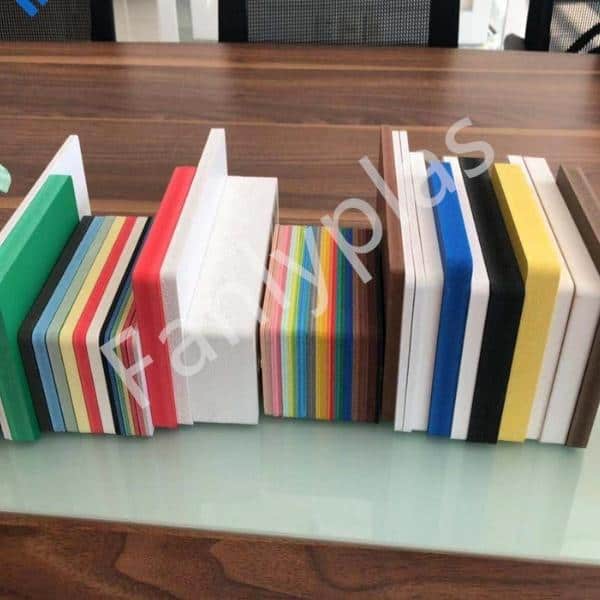
FAQs
What makes PVC foam boards a great option over other products?
PVC foam boards are now taking over other materials applied in manufacturing, construction, and so on. This is because, PVC foam boards are the only products that show reliability, dependability, and quality and are eco-friendly. At the same time, PVC foam boards are water-resistant, fire-resistant, and corrosion resistance which makes them beat other materials hands down since they are affected a lot by the three factors.
Are your PVC foam boards of standard size and measurement fixed?
PVC foam boards have a standard measurement of 5.188m thickness and 8*4 feet (this is not fixed). However, here at FANLYPLAS, you can get your own customized PVC extrusion machine that is made to the specific design you have selected with the measurements needed.
Conclusion
PVC foam boards are arguably the best choice in any sort of application and they are taking over other materials at a skyrocketing speed. We are dedicated to producing and exporting efficient and reliable PVC foam board production lines to our customers no matter the destination. Out machines will ensure your dream of producing quality and top-notch PVC foam boards come to reality. All you have to do is come up with a design of your own if you want a custom-made machine and we finish up the rest. We are an established company that is trustworthy and affordable to work with.

